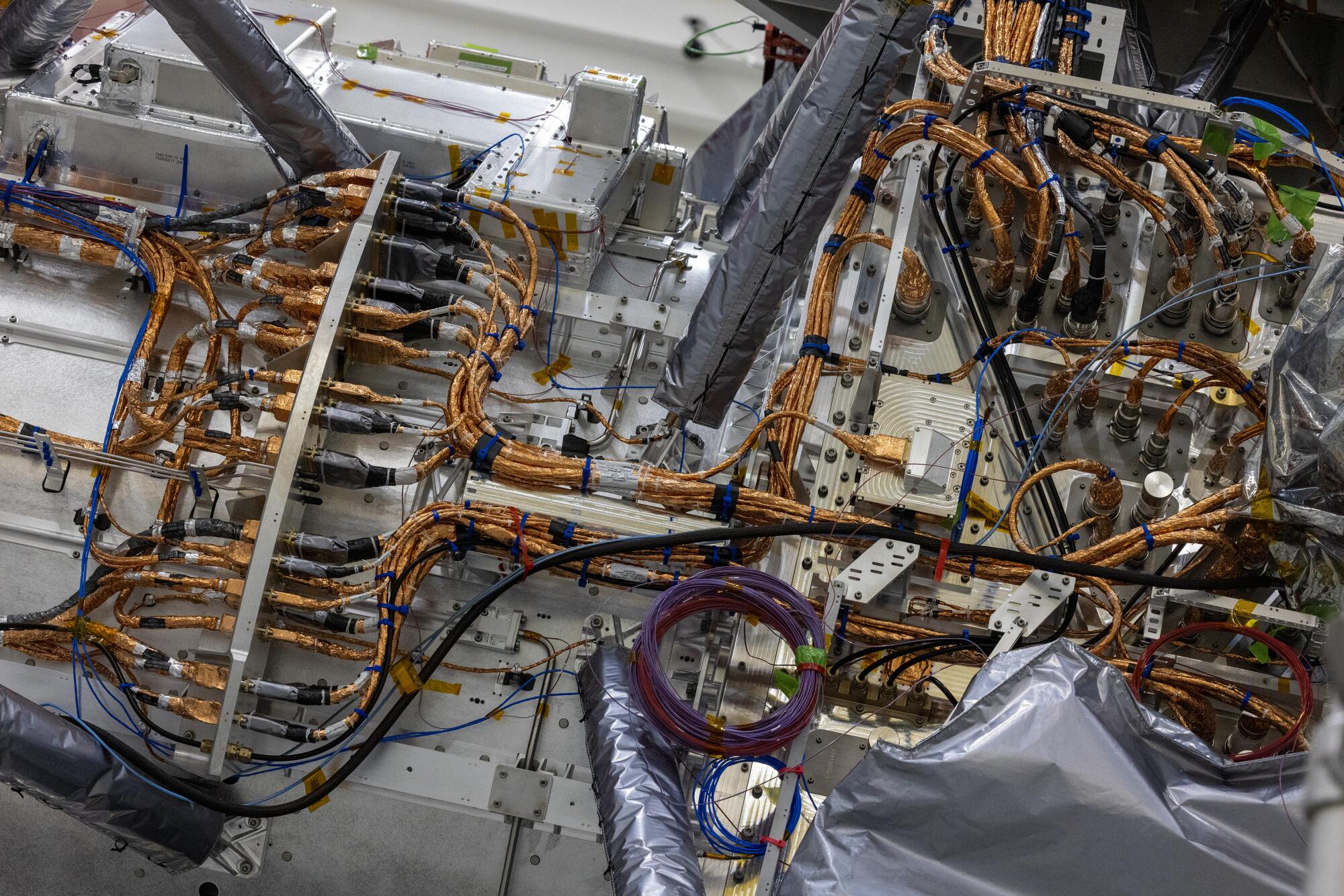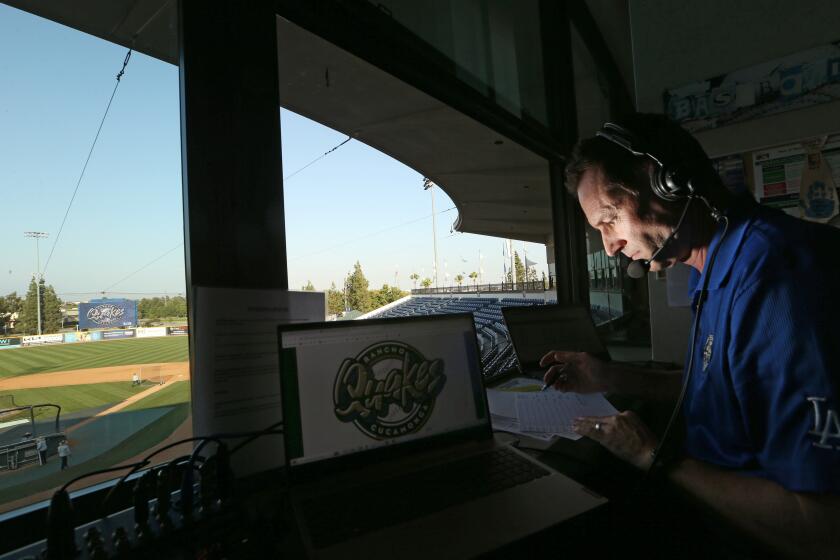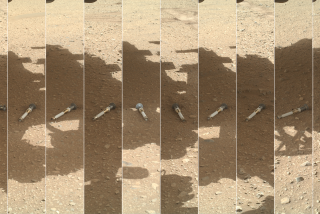
Think of meticulously handcrafted objects, and certain things come immediately to mind: fine art, exotic cars, luxury timepieces.
But Pasadena native Steve Barajas spends his days building a bespoke item that’s on another level entirely: NASA’s Europa Clipper.
BUSINESS
What do you do for work?
That’s the question My L.A. Workday answers. The series takes you inside a day on the job with some of the city’s most fascinating people. Interviews are edited for length and clarity.
The 13,000-pound behemoth, with a solar-array wingspan the length of a basketball court, is one of the space agency’s most ambitious efforts. It’s on an October countdown to launch to Jupiter and its moon Europa, atop a SpaceX Falcon Heavy rocket, to find out whether life exists in the deep ocean believed to lie beneath Europa’s icy exterior.
The central body of the $5-billion Europa Clipper arrived in June 2022 at the La Cañada Flintridge campus of NASA’s Jet Propulsion Laboratory for the painstaking final assembly of components shipped from across the U.S. and Europe. That’s where Barajas comes in.
Barajas, 35, is a mechanical engineer leading a team that, in coordination with other JPL specialists, installs crucial hardware for the mission. Barajas describes some high points with a parental flair: There’s the magnetometer that could confirm whether an ocean exists beneath the Europa ice; the mass spectrometer that will analyze gases in Europa’s atmosphere; the infrared cameras that will map the moon’s surface composition, temperature and roughness; and the solar panels that will help power the spacecraft’s instruments.

The project’s momentum to liftoff didn’t spare the Europa Clipper team when JPL in early February laid off 530 people, or about 8% of its workforce, because of uncertainties over congressional funding for NASA. Although the job cuts, the second round this year, were felt “across the NASA family,” NASA Administrator Bill Nelson said, “the Europa Clipper mission will proceed as planned.”
Searching for the ingredients for life on Europa will be a challenge for NASA’s Europa Clipper spacecraft. Surviving the high radiation of the icy moon will be even harder.
In his official NASA bio, Barajas recalls his childhood fascination with space. “As a kid, I remember passing the sign along the 210 Freeway that read ‘NASA-JPL Next Exit,’ thinking it was so cool that NASA was so close,” it reads.
The UC Berkeley graduate, who joined JPL in 2016 from Aerojet Rocketdyne, said his work has taught him the art of delayed gratification. If the Europa Clipper launches on schedule from the Kennedy Space Center in Cape Canaveral, Fla., Barajas will have to wait 5½ years for it to arrive at Europa, about 488 million miles from Earth, where it will perform dozens of flybys of the moon to collect data.
“I’m working on a spacecraft that will hopefully find something profound in the future, and working with people who share the same passion,” he said.
Private dog parks are in high demand as affluent city dwellers seek elusive green spaces for their pets to socialize and roam off-leash.
When JPL finishes the build-out, Barajas will be part of the team that flies to Florida in May for launch preparations, with liftoff scheduled for as early as Oct. 10.
The Times spent a day with Barajas on the job late last year. The interview was edited for length and clarity.
5 a.m.
Barajas starts his day studying a pile of activity reports from the previous day’s work to create a tactical schedule for the mechanical engineers on his team.
Today is a big day for the Europa Clipper team. They’ll be testing the craft’s thermal pumping system, the last major addition to the spacecraft’s vault, a thick-walled aluminum alloy box that holds the spacecraft’s “brain”: its electronics and computers.

“The thermal pump is the heart of the spacecraft,” pumping fluid through tubing to control the craft’s temperature, Barajas said. The dayong effort is hazardous because of the high pressure used to test the system with helium, a nonflammable gas.

7 a.m.
The Europa Clipper’s tall silvery core stands in JPL’s Space Assembly Facility in the High Bay 1 clean room surrounded by temporary scaffolding. In a nearby conference room, Barajas represents the mechanical engineering team as he compares notes for the day ahead with colleagues from the electrical engineering and systems teams.
As a meteorologist, Rose Schoenfeld’s job is to keep the public informed of severe weather. For her and her colleagues, Hurricane Hilary is ‘a once-in-a-lifetime kind of event.’
“Some of what we are discussing are small details. It usually isn’t a massive revamp of the plan,” Barajas said. “It’s trying to get everything organized so that we can provide very clear direction when we meet with the rest of the teams at 7:30.”

9 a.m.
Before any work on the spacecraft begins, Barajas and his colleagues have to don the white protective coveralls known as bunny suits. Barajas will have to repeat the procedure three times before the day ends.
Collegial chatter abounds because some people entering the clean room for the first time need help with the process.

“Every time we enter the clean room, we have to first put on the bunny suit, which is a very ugly one-piece jumper,” Barajas said. “Empty your pockets; no phones or watches. Shoe covers go on your feet, then there are boots that go on top of those. If you have a beard; there’s a mask to wear for that. Then there’s a face mask, and a hood that’s like a fabric helmet goes over that. Then you put on the bunny suit without letting it touch the ground. Then there’s tape on all of the separate parts, joining the legs to the shoes, gloves to the sleeves, etc.”
The process must be repeated after a worker leaves the clean room for lunch or a bathroom break — “It’s one of the daily downsides of the job” — so veterans know, “you’re not able to hydrate as you would normally.”
Next, there is something that looks like a shower stall, buts it’s dry air being blasted at the occupant, hard enough to feel like a windstorm.
Rami Almordaah is chief authenticator at sneaker resale store CoolKicks. It’s his job to identify fakes and drive hard bargains for sneakers that collectors want to sell.
On one wall of the clean room hang plaques commemorating missions that date back 63 years, to the Ranger 1 moon mission, when engineers worked on spacecraft in street clothes. But this is not 1961, a time when earthlings weren’t concerned about spreading their biological junk off the planet.
“Planetary protection has evolved,” Barajas said of the strict work requirements he has to follow every day. “No one wants to be the person responsible when extraterrestrial life is finally found and it turns out to be something we brought there from Earth.”

9:30 a.m.
Inside the clean room, engineers and technicians are making sure all the fittings on the thermal pump are sufficiently tight.
There is no chatter, no small talk. Everyone is looking intently at the work being done, a level of scrutiny that continues during the testing process. Barajas is there to ensure that members of the thermal team conducting the test have everything they need and the work is going smoothly.
“We have detectors here on the clean room floor that will read whether anything is seeping out. We do this with helium,” Barajas said. It has to be below a certain rate loss. “There will always be some seepage, but as long as it’s not too much, we’re OK.”

10:30 a.m.
There are two thresholds for success. One is a vacuum test using a wand spraying helium to see whether it is being sucked into the system. The other is the high-pressure test in which helium is pumped through the system to see if whether gas is leaking.
Any significant leaks will interrupt the tight choreography of the spacecraft’s assembly and testing schedule, less than a year away from launch time.
Ever wonder what a baseball broadcaster does? Inside the booth with Mike Lindskog, the voice of the Rancho Cucamonga Quakes of the Dodgers’ minor league team system.
“We are physically putting the spacecraft together. We are the end of the line,” Barajas said, trying to explain the serious atmosphere in the room. “It’s up to us to verify that the parts we have been sent are working the way they should. Humans aren’t infallible. We’re always looking over each other’s shoulder to make sure we’re doing the job right.
“I think that’s where the stress comes from, right? That we feel the pressure and the burden of building this vehicle that has been the life’s work of some and years of work for many others.”

1 p.m.
It’s lunchtime. You might think that the pressure of tight deadlines would cause Barajas and others on the project to push through to stay on schedule. Bad idea, Barajas said.
“We always make time for lunch,” he said. “What we don’t want is to have hungry people on the floor. Sometimes we cycle people in and out so that the work can continue. Other times we just take a 45-minute break, so the folks can stay focused on the floor when we are having a long day like this.”

2 p.m.
Barajas steps out of the clean room to catch up with phone calls and email.
“In my particular role, the brunt of the day is a lot of behind-the-scenes work,” Barajas said. “To keep things moving, looking ahead to the next job.”
There’s the occasional startling interruption of tour guides speaking in the hall outside his office as they lead groups through the Spacecraft Assembly Facility. The main attraction is the window into the clean room, where tours can see the spacecraft itself.
“There’s a constant stream of tours during the day. It’s like working in a fishbowl,” Barajas said with a laugh.
Art restorer Henri Laborde will repair art from Sotheby’s, Christie’s — and your living room shelf. Here’s how he stays focused on the delicate work.
3 p.m.
The workday comes to the 3 p.m. change of shift. But Barajas isn’t knocking off; he’s gone back to the clean room as testing continues. Barajas needs to make sure that the second shift is able to pick up where the first left off.

4 p.m.
The tests are done and the teams determine that there were no leaks. But there isn’t even the briefest of celebrations for this achievement.
“We’ve got so much still to do. Interim steps don’t really get much of a response from us,” Barajas said.
Barajas and colleagues turn their focus to the next few days, when they will fill the system with Freon and then close the spacecraft’s aluminum vault for good.
“That will be a milestone, not just for us, but for the whole project,” he said.
That might even get a high-five.














